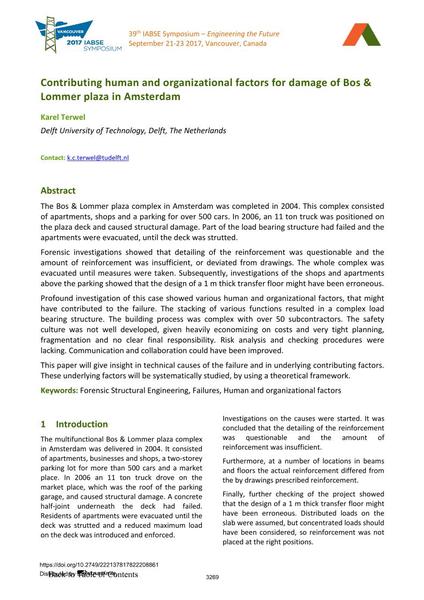Contributing human and organizational factors for damage of Bos & Lommer plaza in Amsterdam

|
|
|||||||||||
Détails bibliographiques
| Auteur(s): |
Karel Terwel
(Delft University of Technology, Delft, The Netherlands)
|
||||
|---|---|---|---|---|---|
| Médium: | papier de conférence | ||||
| Langue(s): | anglais | ||||
| Conférence: | IABSE Symposium: Engineering the Future, Vancouver, Canada, 21-23 September 2017 | ||||
| Publié dans: | IABSE Symposium Vancouver 2017 | ||||
|
|||||
| Page(s): | 3269-3276 | ||||
| Nombre total de pages (du PDF): | 8 | ||||
| Année: | 2017 | ||||
| DOI: | 10.2749/222137817822208861 | ||||
| Abstrait: |
The Bos & Lommer plaza complex in Amsterdam was completed in 2004. This complex consisted of apartments, shops and a parking for over 500 cars. In 2006, an 11 ton truck was positioned on the plaza deck and caused structural damage. Part of the load bearing structure had failed and the apartments were evacuated, until the deck was strutted. Forensic investigations showed that detailing of the reinforcement was questionable and the amount of reinforcement was insufficient, or deviated from drawings. The whole complex was evacuated until measures were taken. Subsequently, investigations of the shops and apartments above the parking showed that the design of a 1 m thick transfer floor might have been erroneous. Profound investigation of this case showed various human and organizational factors, that might have contributed to the failure. The stacking of various functions resulted in a complex load bearing structure. The building process was complex with over 50 subcontractors. The safety culture was not well developed, given heavily economizing on costs and very tight planning, fragmentation and no clear final responsibility. Risk analysis and checking procedures were lacking. Communication and collaboration could have been improved. This paper will give insight in technical causes of the failure and in underlying contributing factors. These underlying factors will be systematically studied, by using a theoretical framework. |
||||
